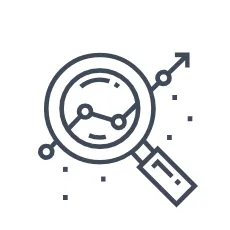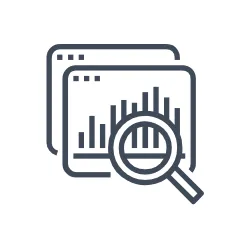Financial Clarity Starts
with Trusted Books
Led by a CFO, Not a Bookkeeper
You can’t make confident decisions with numbers you don’t trust. We fix your financial foundation, deliver reliable reporting, and guide you with CFO-level insight - so you finally know what's working, what’s not, and what to do next.
No pitches. Just clarity on your numbers and next steps.


Integrity
We treat your business as if it were our own. Our success is measured by your success.

Accuracy
We leverage the latest technology to ensure accuracy and focus on what matters most.

Growth
Whether it is your business or personal, we focus on setting goals and keeping you accountable to each milestone.
If Your Numbers Don’t Make Sense…
It’s Not Your Fault
Most business owners are stuck with reports they can’t use. The books are “technically done,” but nothing adds up. Cash moves without warning. Profit feels random. Strategy is guesswork.
You can’t trust the reports your team or CPA hands you
You’re growing, but still unclear on real profitability
Cash flow surprises keep you playing defense
You’ve outgrown basic bookkeeping — but aren’t ready for a full-time CFO
It’s not an accounting problem. It’s a leadership problem. And that’s exactly where we step in.
WHY WE’RE DIFFERENT
Not Just Bookkeeping.
Not Just CFO.
A Financial Partner You Can Trust.
We don’t simply categorize transactions. We build financial systems you can actually run your business on. Every number is checked, every report is explained, and every decision is supported with clear, forward-looking insight.
Accuracy – Clean, reliable books you never have to second guess
Clarity – Reporting you can actually read and make decisions from
Leadership – CFO-level guidance to help you plan, price, and grow
We’re not here to impress your CPA. We’re here to empower you, the owner.
Our Service Path...
Where your numbers stand today determines your next financial stage.
Foundations - Fix & Stabilize
For businesses with messy or unclear financials.
First we build clean, dependable books and core reporting — so you finally know where you stand.
Bookkeeping clean-up & restructuring
Reliable monthly financials & reporting
Cash flow organization and tracking


CFO Navigator - Clarity & Direction
For owners who need guidance, not just reports.
Once the numbers are right, we help you interpret them — and make confident, data-driven decisions.
Monthly financial review & strategy calls
Budget vs. actual tracking & KPI insight
Forecasting and scenario planning
Fractional CFO - Strategic Growth Partner
For companies ready to scale deliberately.
We function as your financial executive — leading pricing, planning, capital decisions, and long-term strategy.
Growth planning & profitability design
Executive financial leadership & dashboards
Board-ready forecasts, capital guidance

We have happy clients
From Confusion to Confidence
Real Results from Owners Like You
"Highly recommend!"
"From day one, their CFO service have brought clarity and confidence to our financial strategy. With their guidance, we've navigated challenges more effectively and seized opportunities we otherwise might have missed. They offer more than just advice; they deliver peace of mind."
- James C.

"Truly a partnership we value"
"Finding a team that not only understands but also anticipates the financial needs of a small business like ours has been a game-changer. Their bookkeeping and CFO services have freed up so much of our time, allowing us to focus on growth and innovation."
- Mason T.

"An integral part of our team"
"I was initially skeptical about outsourcing our financial services, but this team has proven to be a priceless asset. Their expertise in accounting and strategic financial planning has directly contributed to our bottom line."
- Liam A.

"Incredible support and expertise!"
"I was dreading the accounting part of my business, but these folks made it so simple and stress-free."
- Aiden H.

"Absolutely invaluable service"
"Super impressed with their accounting team. They caught discrepancies we missed and helped us streamline our finances."
- Sarah H.

"Can't recommend them enough!"
"Signing up was the best move for my business. Their team is responsive, knowledgeable, and genuinely cares about our success."
- William T.

Latest Insights

Why Most Small Businesses Fail at Forecasting… and How to Fix It
Master financial forecasting for your small business - our insights show why most fail and how to get it right. ...more
KPIs, Budgets & Forecasting
June 27, 2025•9 min read

How to Manage Seasonal Cash Flow in a Service Business
Manage seasonal cash flow challenges in your service business with expert tips and strategies. ...more
Cash Flow & Profitability
June 13, 2025•11 min read

How to Build a Budget That Actually Drives Growth
Discover the secrets to small business budgeting that drive real growth. Our step-by-step guide can help. ...more
KPIs, Budgets & Forecasting
May 30, 2025•8 min read
We have answers
Frequently Asked Questions
We understand that hiring someone to help you with your business can be stressful. Here are some of the most common questions we get from people in your shoes.
How much does your service cost?
We offer tailored services recognizing each business's unique needs. By evaluating your annual requirements, we create a fixed monthly service package encompassing all your needs. Our pricing model is both fair and transparent, designed to provide value and simplicity.
Do you offer a guarantee?
Yes. Our CFO services are backed by a 30-day satisfaction guarantee. If you’re not happy within the first month, we’ll refund your payment — no questions asked.
Can you work with my internal finance or accounting team?
Yes. We often collaborate with internal controllers, bookkeepers, and leadership teams to deliver higher-level strategy and insights.
Do you have experience in XYZ industry?
Our clients span various industries, and while we don't specialize in a single sector, we customize our reporting to meet your needs and pinpoint your unique KPIs. Despite industry differences, we've discovered the fundamental principles of business remain consistent.
How long does it take to fully onboard?
If no major cleanup is needed, we begin immediately on day 1. Within 30 days, we aim to thoroughly understand your business and deploy all necessary tools for efficient management, ensuring a smooth and effective operation tailored to your specific needs.
Do you offer tax preparation service?
While we don't provide tax preparation services, we partner with a network of excellent CPAs. This collaboration allows us to utilize their tax expertise, enabling us to concentrate on supporting your business growth through financial insights and operational improvements.
Can I hire you for a project?
We exclusively offer ongoing services, with the exception of initial bookkeeping cleanups for new clients. This approach ensures we dedicate 100% of our attention to delivering the highest quality service to our existing customers.
© Copyright 2025. The Pro CFO. All rights reserved.

